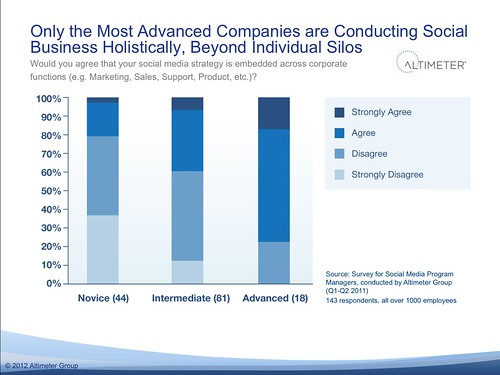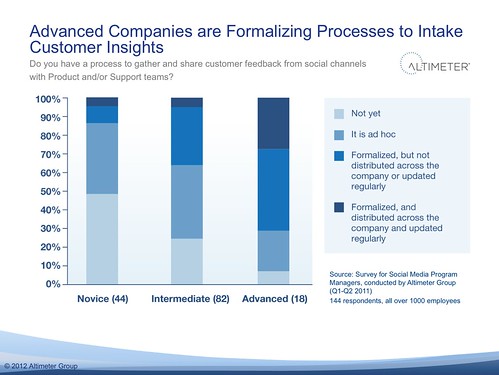Recently, folks suggested that social business space was getting washed out, especially with Social Media Week spreading across the globe and being hosted at many corporations. Yet despite the interesting and activity around this topic, many folks are confused around what maturity really looks like. Managing a Facebook page to promote the latest campaign isn’t really social business, it’s just social added to existing interactive marketing.
I was talking with industry peer Michael Brito (former Intel and now at Edelman) about the maturity of the space at Cisco’s social media week yesterday, and we both agree this space is just heating up. But don’t listen to us, instead, let’s review a sample from a recent Altimeter Report on Social Business of what actual corporate decision makers said in a recent survey:

Figure 1: Only the Most Advanced Companies are Conducting Social Business Holistically, Beyond Individual Silos

Figure 2: Advanced Companies are Formalizing Processes to Intake Customer Insights

Figure 3: Only the Most Advanced Companies Are Integrating Social Data into Customer Databases
Let’s take a look at this data, to understand why the social business space is still very immature:
The Industry Isn’t Mature, Few Have Reached Advanced
Altimeter’s research often segments buyers by their maturity, as it helps to forecast future behaviors and we wanted to share this today. First note this maturity breakout of these corporations (many of which are global national) that have over 1000 employees: novice are 44, intermediate 81, and advanced are 18. Percentage wise, we see that 56% of the 143 are lumped in the intermediate stages, followed by 30% of the market in novice, and followed by the remaining advanced a mere 12% of the set. What does this mean? While most companies are past the experimentation stage, they’ve yet to roll these out across the corporation or think bigger than campaigns or specific business units.Limited Integration Across Business Units, Products, and Customer Databases
Looking at Figure 1, we can see that many companies are not even integrating this across their enterprise. We know from data that rollout usually starts in Marketing (with a segment of that being corp comm), followed by customer support who has to respond to angry clients, followed by product teams, and then low adoption for partner ecosystem and supply chain. One sign of an advance company is the ability to integrate customer feedback into the product roadmap in Figure 2. We know this is a sign of maturity as it requires both vertical approval from executives and broad approval across product lines and beyond –it’s often against the culture of many engineering groups. Lastly, in Figure 3, companies barely even have a full view of their customers in the social space, as data is siloed among brand monitoring, locked in Facebook apps, and spread among the company.Understand What Advanced Corporations Look LIke
There’s a few criteria I look for when seeing if a company is advanced beyond the three figures presented above. Nearly all employees are using social in a safe and organized way (called Holistic). Another criteria is data is being aggregated from multiple locations and the company is able to predict and anticipate what customers are going to do. Thirdly, they stop using the terms ‘social business’ and just use the term ‘business’ as this integrates into their normal digital communications. While somewhat dated (2010) I created a list of what an advanced company looks like, although I feel it needs updating in 2012.
I look forward to hearing from you, what are you seeing: Are companies starting to mature? What are your indicators?
For many of the Big Pharma client’s I talk to the whole concept remains alien, scary and something they wish would go away. But there are some signs that this is changing and they are just beginning to realise they HAVE to engage. Just best not to use the term Social Media in any discussion – until the benefits of the interaction have been clearly established.Â
For many of the Big Pharma client’s I talk to the whole concept remains alien, scary and something they wish would go away. But there are some signs that this is changing and they are just beginning to realise they HAVE to engage. Just best not to use the term Social Media in any discussion – until the benefits of the interaction have been clearly established.Â
Really appreciate how you’ve recontextualized this data, Jeremiah. Â
Even for large companies that are actively pursuing the principles of becoming a social enterprise, it can be easy to mistake progress for maturity; I’d cite your point about the lack of integration as the core differentiator, and it is a yawning gap for massively matrixed organizations. Â Â Â For the majority of companies, though, it’s hard to be mature when you don’t know what adolescence is. Â 🙂 Â And as pointed out in the comments, the terminology creates confusion, not clarity, and drives decisions that – shockingly – don’t produce the desired outcome. Â So while the discussion about what these things actually mean rages on, I’ve found that establishing a basic framework as below, with some very clear distinctions and dependencies, helps companies begin to understand what it is that they actually aspire to and start toddling in the right direction. Â
Social Business describes operations; how a business conducts itself and functions to connect with its customers and employees; and the people, processes and technology required for doing so.
Social Engagement describes the activities and outcomes of connecting to and building relationships with your customers and stakeholders, including the identification, activation and ongoing engagement with your most ardent advocates.
Â
Social Media describes the tools and technology for connecting with your customers and stakeholders; it is the mechanism for executing on Social Engagement and building a Social Business.These aren’t meant to be definitions, but simply to create some clarity so that companies can have a meaningful discussion about these things in the context of each other versus munging them all together.
one ring to rule them all…